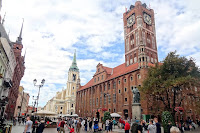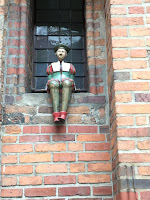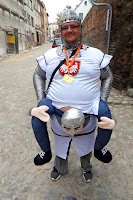Torun
In the 13th century, Torun, lying adjacent to the Vistula River, gained prominence under the control of the Teutonic Knights. The city’s major attraction is its walled “centrum” which has preserved the original medieval architecture; the city was not destroyed during World War II. Torun was the birthplace of Nicolas Copernicus; the first astronomer who stated that the sun was the center of our universe.


We arrived in Torun around 10 AM and proceeded to our hotel to unload the bus. Since we were spending only one night here, Kasia immediately led us on a walking tour of the old city. The architecture that we were seeing dates back to the medieval times; unlike Warsaw and Gdansk, which were destroyed during World War II. In the midst of the town square stood a statue of Copernicus, framed by the city’s 13th century Gothic Town Hall. Some of our visual discoveries included a bronze donkey, violinist water fountain statue framed by six bronze frogs, a medieval gnome sitting on a window ledge, a prostrate green dragon figurine, a recently discovered fresco of St. George slaying the dragon and “what’s going on” poster kiosk.
Appetizing discoveries included a gingerbread emporium offering a wide variety of gingerbread delicacies and the ubiquitous donut shop. I confess that I was unable to resist the temptation to explore their offerings.
Fortunately, this weekend the city was hosting a Copernicus festival with 1,000s of young people roaming the street. Some in elaborate costumes as if it was Halloween.
We stayed at a lovely 4* hotel, Hotel 1231, located next to the midlevel fortification wall and adjacent to Poland’s main river, the Vistula. Nice dinner...tired...went to bed early....
















No comments:
Post a Comment